Thirsting for the Forbidden: Dissecting the Monstrous Feminine
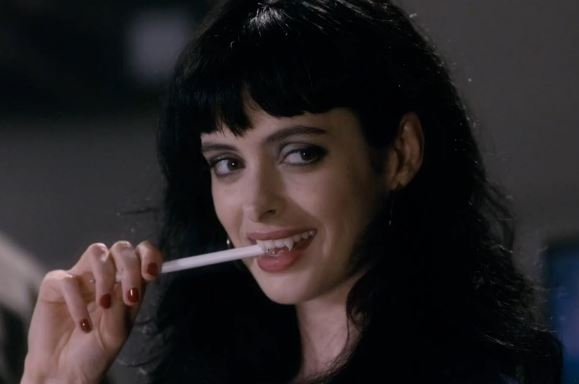
“The female vampire is abject because she disrupts identity and order; driven by her lust for blood, she does not respect the dictates of the law which set down the rules of proper sexual conduct” — Barbara Creed
Within nearly every subcategory of the horror genre, women fulfill a unique role as both villain and victim. Barbara Creed, a feminist film theorist specializing in critique of the horror genre, has identified several character archetypes. Women are thus deemed virtuous or monstrous by the viewer through the lens of patriarchal ideology.
Creed’s 1993 book “The Monstrous Feminine” explores the female vampire as a distinct archetype in horror films that is completely separate from her male counterparts. Women as vampires represent a type of femininity that is forbidden in the eyes of the patriarchy. The female vampire’s passionate relationship with death paints her as an agent of the Devil. They are independent and erotic, defying the conventions and moral codes laid out by Western religions.
Female vampires are particularly nuanced characters because of their inherent sexuality. The concept of vampirism is intertwined with eroticism. So often, the female vampire is depicted with a fascination for the human world—it is familiar, yet alien. She teeters along the lines of dead and alive, young and old, human and beast. Vampires are predators living on the fringes of society, condemned to an eternity of fractured identities. They yearn for a love that is forbidden by nature yet impossible to resist. What could be more romantic than sinking your teeth into someone else’s neck?
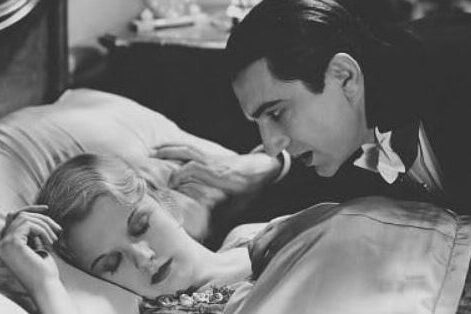
Pinpointing the exact beginning of the American horror genre gets to be foggy, but one clear turning point was the 1931 theatrical release of Todd Browning’s “Dracula.” That isn’t to say monster movies did not exist in other parts of the world prior to 1931. German expressionists set the precedent with “The Golem” in 1915, a silent film based on Jewish folklore that is regarded by historians as the first of its kind. “Nosferatu” followed soon after in 1922, presenting Count Orlok as a clear imitation of Bram Stoker’s Dracula.
The classic vampires we know and love now bear a much closer resemblance to Bela Lugosi’s iconic performance. Despite “Dracula” being an adaptation of an adaptation, drawing greater inspiration from the stage play rather than the novel, it became a cultural touchstone for writers and directors. Today, vampires are depicted as anything ranging from grotesque aristocrats to glittery teenage heartthrobs. However, their one universal characteristic is their ineffable and insatiable bloodlust.
Ana Lily Amirpour’s 2014 debut film—the world’s first Iranian Vampire Western—“A Girl Walks Home Alone at Night” serves as both an example of and a subversion of this trope. Sheila Vand, referred to only as “The Girl,” is a lonesome woman who spends her nights stalking the streets of Bad City, skateboarding and occasionally carrying out vigilante-like justice. She torments, oftentimes killing men who she deems to be bad. While the way in which the title, “A Girl Walks Home Alone at Night” plays out is already a subversion of expectations (The Girl is safe, the men around her are not), the way that this female vampire is portrayed throughout the film starkly contrasts western conceptions of what a vampire should be.
The Girl dons a chador, a traditional, floor-length Muslim headdress, in place of a typical vampire’s cape. This detail is more than just a nod to the director’s Iranian roots. As stated in Zahra Khosroshahi’s article in Foreign Policy Magazine, the inclusion of the chador “subverts the image of the veiled woman as submissive, turning the victimhood suggested by the film’s title on its head.”

Amirpour’s depiction of a vampire also subverts western conceptions of sexuality. The scenes depicting The Girl’s murderous acts initially appear sexually charged when the viewer, much like her victims, is not privy to her true identity. She lures men in with her mystique and sexuality before trapping and killing them. This is overtly shown in the first instance in which she kills a man.
Saeed, an abusive drug dealer and pimp, allows The Girl to come back to his house after she witnesses him abusing one of his prostitutes from a distance. She disarms him in a seemingly comfortable environment by sucking on his finger suggestively. Upon revealing her fangs, Saeed is taken aback. He hesitates to touch The Girl. However, he is overcome with a desire to examine her mysterious appearance, leading to a gruesome and vulnerable demise. This scene falls within the first act, setting the tone for the rest of the film. The viewer is forced to grapple with their perception of The Girl. She is small and inconspicuous and yet she is capable of great violence. One must assess their viewpoint of The Girl and the people around her, deciding for themselves whether they are deserving of her verdict.
As objectionable as bloodsucking already is, the nature of vampires becomes even more taboo when their lovers and victims are of the same gender. Lesbian vampires are not a new concept, dating as far back as Sheridan Le Fanu’s 1872 novella “Carmilla.” The trope of the predatory queer woman has been perpetuated by the horror genre for centuries. It is a means of demonizing sexual promiscuity and any individual expression belonging to the counterculture, whether that expression takes the form of fashion, writing, or artwork. The most compelling aspect of queerness in vampire stories is that it is so rarely explicit. You may be inclined to think Louis and Lestat are the only examples, but once you know what to look for, the allegories are impossible to ignore.
A recent example of queer subtext in a seemingly heterosexual vampire film is “Humanist Vampire Seeking Consenting Suicidal Person” (2023), Quebecois director Ariane Louis-Seize’s debut feature film. Sasha (Sara Montpetit), a 68-year-old teenage vampire, is cut off from her parents’ blood supply when they get frustrated with her pacifist tendencies. Hungry, desperate and still unwilling to kill, Sasha enters into a pact with suicidal teenager Paul (Felix-Antoine Bernard). He agrees that she can kill him so long as she helps to fulfill his bucket list. While this reads as a heterosexual romance on the surface level, subtle details illustrate the subversions.
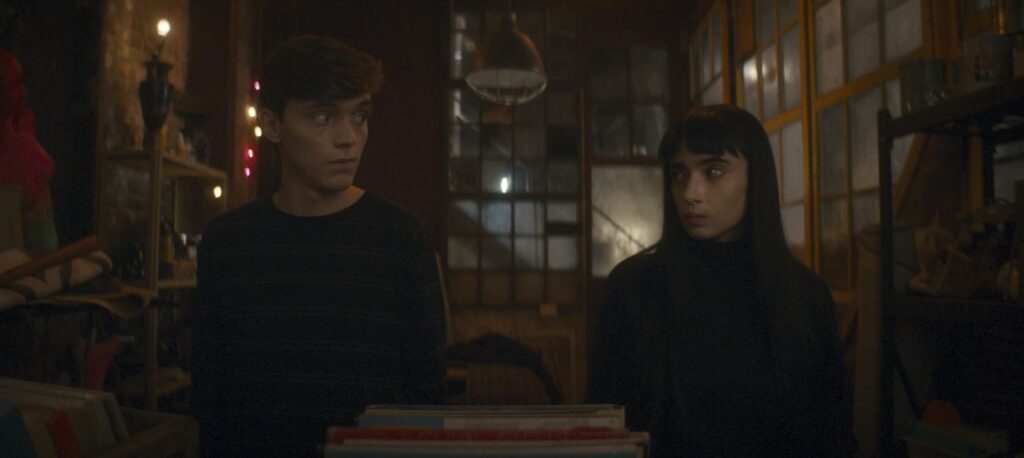
Nothing in the film is overtly sexual, let alone queer. The two main characters never kiss. However, it is made clear early on that vampirism is a metaphor for sex. After their initial pact is made, Sasha and Paul retreat to Sasha’s bedroom and… sit there nervously. They search for distractions, such as Sasha’s record collection. While exchanging nervous glances, they dance to themselves while listening to the entirety of Brenda Lee’s “Emotion,” in a scene reminiscent of its predecessor, “A Girl Walks Home Alone at Night.”
It is a quintessential awkward “first time” scene. Paul asks if he should take his shirt off. Sasha suggests that lying down might make the process easier. Eventually, Sasha concludes that she cannot protract her fangs under pressure. She fails to perform, both literally and figuratively. They call it a night with the goal of trying again later. Sound familiar?
As in “A Girl Walks Home Alone at Night,” the gender roles in “Humanist Vampire Seeking Consenting Suicidal Person” are reversed. Sasha’s fangs force her to take on a dominant role. Her inability to perform under pressure is also suggestive of demisexuality or even “denticular dysfunction,” for lack of a better term. The Girl, on the other hand, utilizes her fangs as a tool to assert dominance. Intimate scenes involving these women are symbolic of unconventional sexual relationships, whether they allude to BDSM culture or the general otherness of queer romance. Vampires in the bedroom don’t always look how one might expect.
As Variety’s review of “Humanist Vampire” points out, vampirism as a myth is oftentimes analogous to kink culture. It doesn’t seem to be the case, however, that the film “unkinks” the act of blood drinking due to a lack of overt sex scenes like Variety suggests. The first instance in which we see Sasha drink Paul’s blood is not from his neck, but from his hand. He cuts himself, allowing the blood to drip into her mouth after she passes out from hunger at a party. This short and chaste sequence is rife with tension despite its inherent sweetness. It is taboo behavior, and yet it is undeniably intimate.
Amy Heckerling’s chick flick “Vamps” (2012) is another campy subversion of vampire tropes that is so bad it’s good. Starring Alicia Silverstone and Krysten Ritter as two undead roommates stalking the streets of New York City, “Vamps” leans about as close to a lesbian buddy comedy as the time period would allow. Goody, who is secretly hundreds of years older than Stacy, relies on her best friend to maintain a lively demeanor. They stay up all night in their parallel coffins, gossiping about the men in their life who are presented as insignificant relationships compared to their friendship.
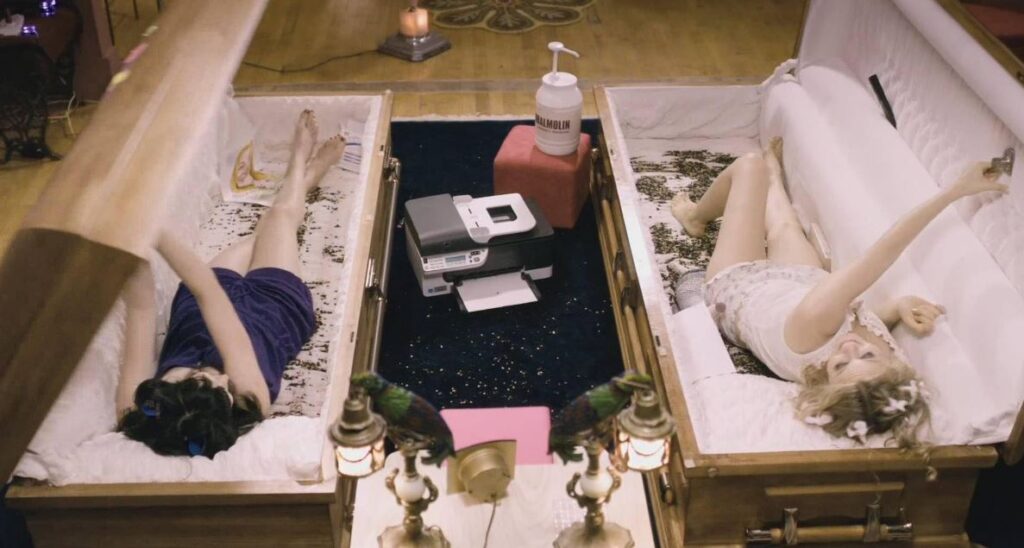
“Vamps” embraces the culture of being an outsider in a big city. It is whimsical, a little bit gothic and the type of cheesy cult classic that leaves you teary-eyed by the end. One crucial element of the film that completely reinvents the vampire archetype is its acceptance of aging. These women are often celebrated for their youthful appearances. They encounter ex-boyfriends who comment on how they “haven’t aged a day” and are allured by the mystique of their secret identities. When Stacy discovers that she is pregnant, Goody rejects everything that makes her attractive and ultimately sacrifices herself by agreeing to take down their “stem,” the woman who turned them into vampires. Otherwise, the baby would be unable to survive in a vampiric womb.
Given Goody’s age, she likely feels as though traditional partnerships with men are the only option despite her flippant dating history. She was bitten in 1841, twenty years before the Civil War had even started, so of course her perspective on what a family should look like is represented by man, woman and child. Heckerling and Silverstone had worked together in the past on “Clueless” (1995), using comedy as a vehicle to depict unconventional romances. It is not so crazy to think that “Vamps” might follow the same formula as its predecessor given its outright rejection of gender roles and its tongue-in-cheek approach to matchmaking.
While not explicitly queer, the chemistry between Silverstone and Ritter as Goody and Stacy feels more genuine and tender than any interactions including their love interests. The death of their stem causes both women to return to their natural ages. Stacy looks about the same, with a few wrinkles here and there. Goody disintegrates into a pile of ash, blowing away in the wind as the sun rises. It is a dramatic goodbye, reminiscent of films like “Gia” (1998) or “High Art” (1998), where lesbian romances are concluded by tragedy.
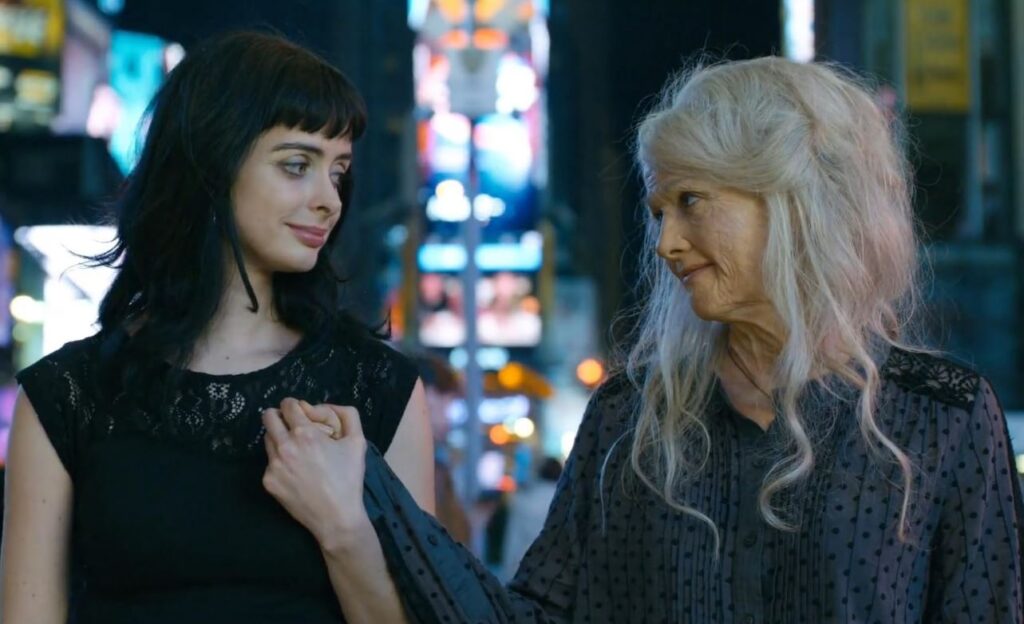
Vampires endure in popular culture as one of the most iconic “monster movie” villains. These female characters demonstrate an evolving understanding of what it means to be a bloodsucker. The feminine vampire can be humane and sentimental. She displays her sexuality without presenting an invitation to unwelcome suitors. A vampire does not conform to the values of the patriarchal society. Instead, she bends the rules to her whim. The Girl, Sasha, Stacy and Goody represent modern women in their most liberated form. After all, when you have that much power at your fingertips, why should you care what a man has to say?
